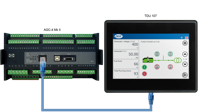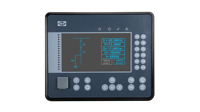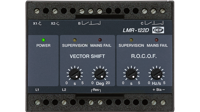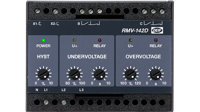Energised and de-energised explained
Relays can be normally energised and normally de-energised, and contacts can be normally open and normally closed. While these terms sound similar, they are not the same; “energised” and “de-energised” refer to the relay as a whole, while “open” and “closed” refer to individual contacts or breakers. In addition, depending on the normal state of the relay, the normal functionality of contacts can appear to be reversed. Which normal relay state to choose is a system design decision.
At DEIF, we sometimes encounter some confusion about the terms “normally energised” and “normally de-energised” in connection with relays. What do they actually mean, and which state is best suited for a relay? And why do contacts in relays sometimes behave in the exact opposite manner to what you would expect?
The DEIF definition of “normal”
To start with, let’s take a look at a couple of factors that contribute to the uncertainty:
- People mean different things when they say “normal”. What is a “normal” situation? Is it when the power is off or on, or is it when a process is running within normal parameters? In other words, does the term “normal” refer to an electrical state (power off or on) or to a process state (normal operation with no alarms)?
- The terms “energised” and “de-energised” are sometimes confused with the terms “normally open” (NO) and “normally closed” (NC) used about contacts. They are not the same, however, and in fact a relay state can cause contacts to behave in a way that may at first seem illogical. We’ll return to this later.
At DEIF, we define “normal” as a situation where the equipment is powered up and running within normal conditions and without any alarms. Consequently, if a relay is “normally energised”, this means that the relay is energised (powered up) during normal operation, while “normally de-energised” refers to a relay that is de-energised (not powered up) during normal operation.
Relays can thus have two normal states: normally energised and normally de-energised. Both are normal and acceptable. Which one to choose is a system design decision that depends on what you want the relay to do. The behaviour of contacts in the relay depends on the state chosen. Let’s see how this works by looking at an example.
Example: alarm relay
In our example setup, a power feeder supplying nominal voltage becomes unstable. The voltage rises, and an over-voltage alarm is triggered, activating an alarm relay. The system thus goes from a normal state to an alarm state. What happens next depends on whether the alarm relay is normally energised or normally de-energised.
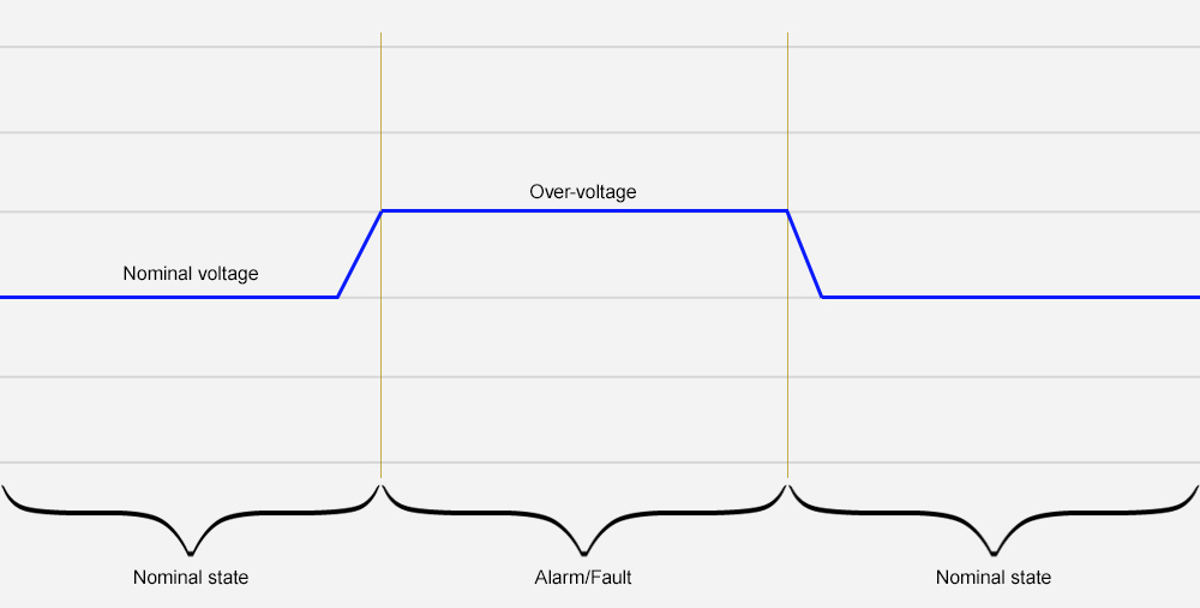
When over-voltage occurs in our example, the relay goes from normal state to alarm state. What happens next depends on whether the relay is normally energised or normally de-energised
- If the alarm relay is normally de-energised, it is energised, or activated, in the alarm state. The normally open (NO) output contact is activated and will close, sending out an output signal. If the normally closed (NC) output contact is used, it is activated and will open, disrupting the output signal.
- If the alarm relay is normally energised, it is de-energised, or deactivated, in the alarm state. In this case, the contacts do the exact opposite of the contacts on the normally de-energised relay: they are no longer energised because the power disappears. The NO output contact will therefore open, disrupting the output signal, and the NC contact will close, sending out a signal output. The contacts thus seem to be in their normal state even though the relay is now in an alarm state, which can seem illogical. See below for an explanation!
Implications for system design
Which normal relay state to choose depends on multiple factors such as the equipment the alarm relay interfaces with, whether the alarm is critical for human safety, and how you want the relay to respond to equipment failures.
If you want to make sure that you can detect if the controller loses its power supply or a wire is broken, for example, consider configuring your relay as normally energised. A normally energised relay is deactivated when the power supply fails and the NO contact opens. By contrast, a normally de-energised relay would not indicate any change when a fault occurred; it would remain deactivated, and its NO contact would remain open.
Choosing a normally energised or normally de-energised configuration is also very useful if your relay has NO or NC contacts, but not both. When you cannot configure system functionality at contact level (because you do not have the choice between NO and NC contacts), doing so at relay level is a good option that provides system flexibility. If the relay only has NO contacts, for example, configuring it as normally de-energised means that your NO contacts close in an alarm situation while the NO contacts would open in an alarm state if you configured the relay as normally energised. You can therefore control your signal path by configuring the relay, and continuously adapt it to your needs by switching between relay configurations.
Why contacts sometimes behave unexpectedly
Why is it that contacts behave in exact opposite manners depending on whether the relay is normally energised or normally de-energised? The explanation has to do with the fact that relay (process) normal is not the same thing as contact (electrical) normal.
During normal operation of a normally de-energised relay, NO contacts are open while NC contacts are closed. This is because there is no power on the relay, and as a result nothing to energise, or activate, the contacts: during a normal state, they are open (NO) or closed (NC) as per contact design. During an alarm state, the relay is powered, and the contacts are activated, closing the NO contact and opening the NC contact. In this case, relay (or process) normal corresponds with contact (or electrical) normal, and the functionality of the relay contacts seems logical.

On a normally de-energised relay, a normally open contact is open during normal state but closes in an alarm state, sending a signal output.
Conversely, on a normally energised relay, there is power on the relay during normal operation, and that power energises and activates the contacts. An NO contact is therefore closed during normal relay operation because the energised relay activates the contact, and similarly an NC contact is open. During an alarm state, the relay is no longer energised. As a result, the NO contact opens while the NC contact closes. In this case, relay normal seems to be the exact opposite of contact normal: When the relay is in its normal state, the contacts are not, because they are activated by the electricity energising the relay. When the relay switches to its alarm state and is de-energised, the contacts are no longer activated and therefore are in their normal, un-energised, or unaffected, state.

On a normally energised relay, a normally open contact is closed during normal state but opens in an alarm state, disrupting the signal output.
The relationship between relay and contact states is summed up in the table below.

As you can see, normal relay states are not necessarily the same as contact normal states, since relays can have two normal states, while contacts can have only one. Note that in many modern relays, the same contact can be configured as NO or NC depending on the configuration of the relay as shown in the illustration below.

excerpt from the DEIF AGC-4 installation instructions showing a controller contact. Depending on the configuration of the relay, both terminal 17 and 19 can be normally closed.
Read more about the DEIF AGC-4 MK II controller
Need support on DEIF relays and contacts? Create a support ticket!
-

Contact us to discuss your options
- 90 years of energy pioneering
- Manufactured at the highest standards
- Superior quality
- Unmatched service and support
- Made in Denmark





